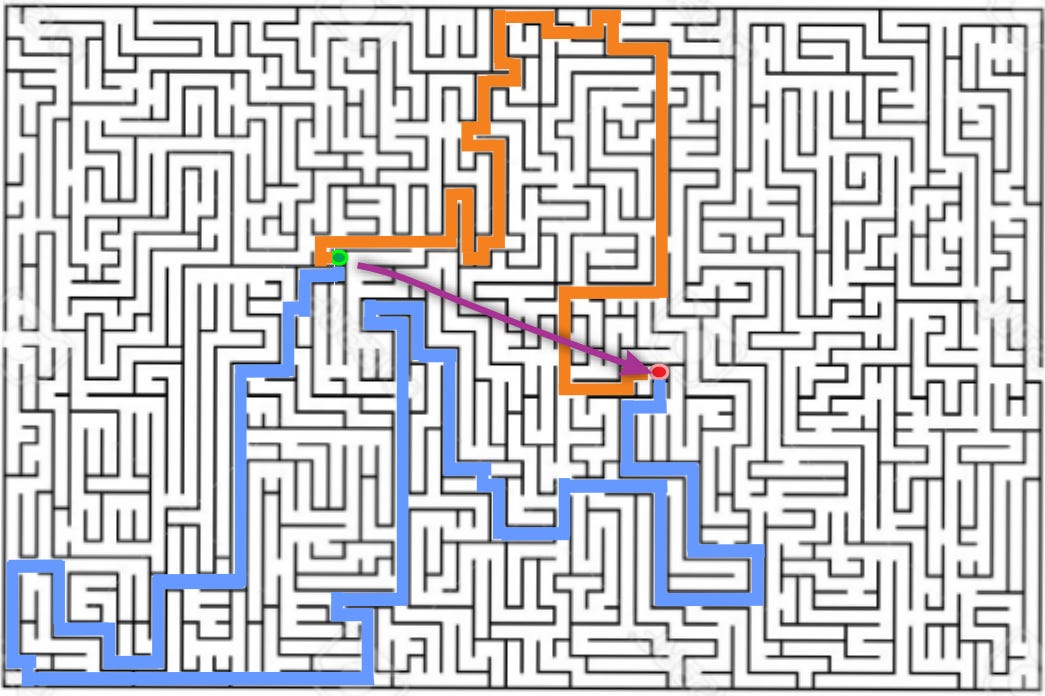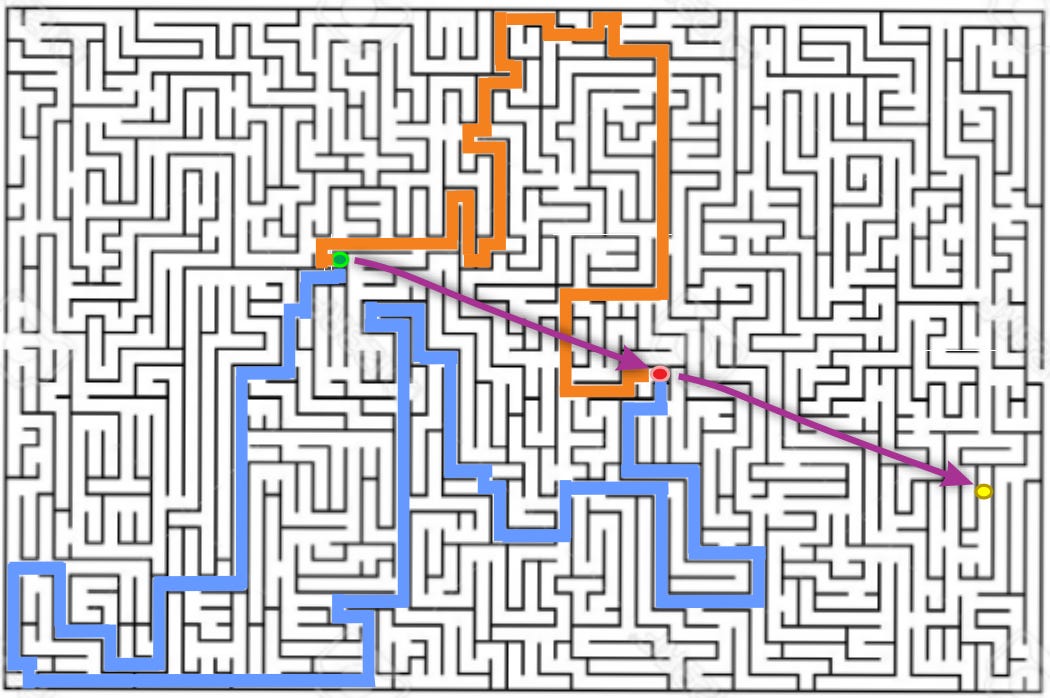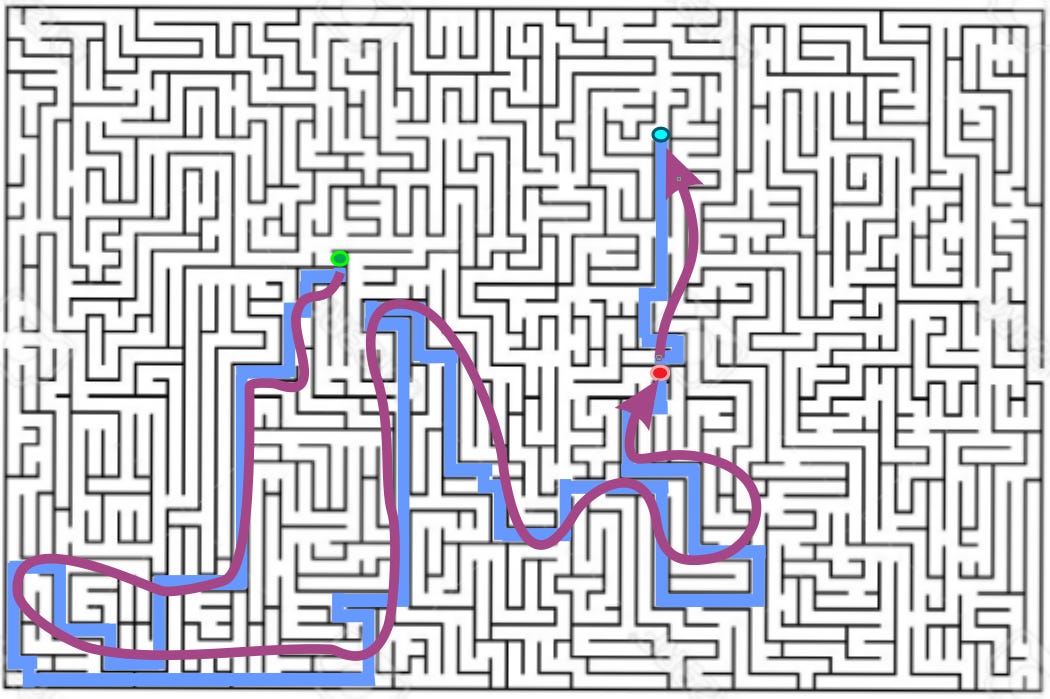Level of Detail and the Dual Nature of Causality
Bottom-up causality is how we tend to understand the world. How does this downward-causality work?
When playing computer video games, what you see as trees in the distance are actually just green and brown boxes. Maybe even just 2 boxes per tree. Bet you didn’t notice! The closer you get, the more detail it creates - 4 boxes, 16 boxes, 64 boxes, then it starts creating bundles of leaves, a trunk… get super close and you’ll see different colored leaves, maybe a squirrel in the tree, and you’ll see them waving in the wind.
This is called “Level of Detail”, and it’s a technique that allows games to run smoothly, so it doesn’t have to spend so much time drawing detail that you won’t ever see because it’s too far away, and too small to notice. Computers are forced to do this because there is limited resources for processing in a short time period.
The same applies with behavior of objects in games. Perhaps there’s a monster in the woods, and this monster snarls and its eyes dart around. But when it’s far away, it does none of that - it isn’t necessary because you won’t see or hear it. Yet when you start to get close, those actions activate and it behaves realistically - and as the player you never know the difference. Again, this saves on processing power so your game runs more smoothly.
Now imagine a game where you could not only get close, but you could get microscopically close. I’m talking about getting close even to the cell level.
You see a person walking past you, but in this game you can zoom in close to their face. And then you can keep zooming, until you see the details of the skin. Individual wrinkles and all. Then you can keep zooming further, and you see pores in the skin. Zoom closer still and you’ll see a drop of oil making its way up the pore. Closer still you see individual skin cells, and you zoom into a melanocyte cell with all its machinations.
Everything in this game has to be 100% realistic, so the cells function just as they would in real life. Their machinations have to explain the behavior that is seen at the zoomed-out level perfectly. You need to see the cell producing proteins, electrons darting down nerves and so on.
Just like the trees and monsters, this too is generated only when you zoom in. Before that, they simply aren’t there.
In all of these cases, we show that games are driven not by low-level causes like cells functioning, but by high level commands: this person moves here, this tree waves in the wind. And all of this behavior is optimized for a first-person view. What you don’t see, doesn’t happen.
According to idealism, the world we experience is likewise optimized for a first-person experience. The details activate only upon inspection, but in the same way the details must explain what is seen at the higher-level, the “classical” world.
But what commands control what happens?
As we have discussed extensively elsewhere in this blog, consciousness works by finding patterns, and has the choice to find either patterns of continuity or association (what we see as coincidences) or knowledge-based patterns (what we see as causes).
The thing is, when we don’t have the knowledge, life mostly works according to association. And when that happens, there will always be multiple bottom-up explanations for the behavior we see.
Where do these explanations come from, though? Does our mind really create them all?
Not entirely, no. These explanations will always represent a path consistent with the laws of physics - taking into account that the laws of physics actually allow for some absolutely incredible seeming behavior (eg. quantum tunnelling). There is some kind of fundamental, almost infinitely varied “reality” - that we have said seems to be what has been described as the many worlds interpretation of quantum physics. Our mind then “finds” those worlds consistent with its conscious state.
An Amazing Analogy
A way to visualize this phenomenon is by imagining a maze.
Consider the two points on the maze - the starting green point, and the ending red point. Now see how there are at least two paths that lead between the two - the top path that is shown in orange, and the bottom path shown in blue. There are likely many other possible paths between the two points - some longer and some shorter, but we’ll just show these two for the purpose of this example.
Now consider this an analogy for two periods in time - the green dot is one moment of consciousness, and the red dot is the next moment of consciousness. As far as we’re consciously aware, we’re conscious at red and then of green, without understanding how we might have gotten from one to the next. And we needn’t even know how.
So at the second (red) point you will see there are multiple, at least two, paths from the green point. If you ask: which path did it actually take? The reality would be that, in a multiverse, it took all possible paths.
On a purely conscious level, you don’t even need to know which path it took. If you disregarded the constraints of the walls in the maze, you may well instead believe that you took a direct path from one conscious moment to the next. I’ve highlighted that direct path in purple below.
So what do you think next? Where do your thoughts go? Without knowledge of these constraints, you may well believe that your line of thinking is on a trajectory of sorts. And the next “conscious moment” is on that same trajectory, perhaps like this:
Now, there are multiple paths from the red point to the new yellow point, so it’s certainly possible to find a way there - and, as we said, in our multiverse of all possibilities, all of those paths will certainly be made.
But let’s say instead when we were at the red point, we start to investigate how we got there. We look for explanations, for paths, and bits come together and we gradually uncover the blue path. And we trace it back and become more and more certain that this is how we got from the green point of consciousness to the red point of consciousness.
Because now the other paths seem not to fit in to our explanation, they disappear from view. As does that “purple arrow” that jumps over them all. Now we’re believing that we’re totally under the control of this blue path.
Now, believing that is the cause, we in turn believe that this path provides us the trajectory of where we must go next. So we set our mind on that, and because of that belief, we find our next conscious moment arises in an entirely different point:
And it keeps going from there, on an entirely different route. Because we believe that the maze walls are dictating our path in the direction it recently came from, we limit ourselves to following only the paths that are consistent with that.
And perhaps eventually we come to the edge - an analogy, perhaps, for our end, death.
Yet if we disregarded those constraints, and followed the trajectory of our line of thought originally, controlling our path only through the mind, then we find that our thoughts can more effectively drive our trajectory, and thus our future. In other words, we will feel free.
Is this why they say “the devil is in the details” ?
Double Slit Experiment?
If we go back to where we started analyzing the paths that lead up to a specific conscious event, it’s possible we have already seen evidence of this phenomenon of multiple-explanations in the quantum physics single electron double-slit experiment.
In this experiment we give a single particle the choice of going through either of two slits, but in either case pick up the path and location of the electron on a screen behind them.
The odd thing is, even with a double slit and single particle, the particle acts as though it goes through both: it produces an interference pattern consistent with it going through both slits at once. A seemingly impossible feat.
Is it possible that what we’re seeing are the multiple paths of possible explanations that lead up to that point of getting a print on the screen? Because it just so happens that the math for those explanations are able to interfere and cause cancellation/interference lines.
Yet if we measure it to check which exact slit it goes through, suddenly it’s like the point where only the blue path appears and the other paths disappear. Our knowledge builds a concrete history, and that interference disappears and we see the result of just 1 particle going through just one of the slits.
There have been different interpretations of this. On the one hand, the Many Worlds Interpretation of quantum physics will tell us that it actually goes through both, in two different universes. And there are likewise two of us, one in each universe seeing it go through one or the other. How those happen to interfere and decohere is not explained satisfactorily, but there have been attempts such as David Wallace’s “decision theoretic”.
Quantum Bayesianism says that our knowledge of the particle causes that history to “reify” - become real. This process is called decoherence, when the alternative paths that make up the ‘wave’ of the particle disappear (or “collapse” into one), and explains how we see a classical world of big objects with solid edges, as opposed to the blurry fuzziness of the quantum world.
The Copenhagen interpretation punts on the question entirely, and simply says that observing the particle causes it to create a single history, in a way that is quite similar to QBism, but without explicitly saying so.
The very fact, though, that we have seen actual evidence of these “multiple explanations” in terms of the wave nature of particles, and the act of “decoherence” that appears to match the acquisition of knowledge that picks a particular explanation (and removes the others), and that such knowledge is non-local (which we seen in entanglement), highly suggests that there are indeed two different forms of causation as we describe here.
Choice of Causation
So we’ve seen that there can, in fact, be two aspects of causation: that which the mind effectively takes, and that which is driven by the constraints of traditional laws of nature: the “walls of the maze”. And, for the most part, we naturally align ourselves to the latter, which enslaves our mind to a very narrow, materialistic world.
But can this be changed? In what way do we have a choice of which aspect of causation to follow? We’ll discuss this in a future post.






